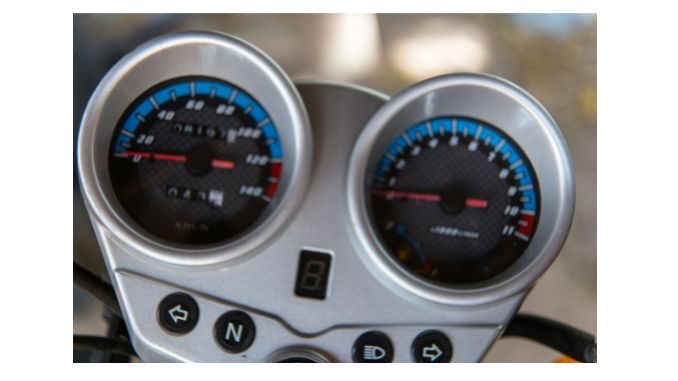
Know in one minute about Instantaneous Velocity
|
Introduction
Instantaneous Velocity is the velocity at a particular instant of time. For example, if the velocity of a car is 20m/s, this means that we are talking about the instantaneous velocity of that car i.e. velocity with which the car is moving at a specific point of the path.
Velocity in simple words describes how fast a particle or object can complete a distance in a particular direction. There are two types of velocity in physics.
1. Average velocity:
It is measured in total displacement upon the total time taken. Or simply
“Average velocity is the velocity measured over a time interval.”
Or “the ratio of total displacement and total time is called average velocity”
Let us understand the simple equation for Average velocity

2. Instantaneous velocity
If we want to calculate the velocity at a particular instant of time during the travel, for this the above formula will not work as it gives the velocity between two time periods during the journey which has a somewhat big difference.
So we use instantaneous velocity to find the velocity at that particular instant of time.
♦ Points to remember
- Time is the main defining factor between average and instantaneous velocity.
- Average velocity is calculated when the time difference is high on the other hand instantaneous velocity is determined when the time difference is only a fraction of a second.
- The main difference between them is their formula.
Let us understand the time difference with the help of a simple equation
As the name suggests, instantaneous velocity is the velocity of an instant of time.
We know the formula for average velocity and that is

Here, the time difference could be big, but if the time difference becomes as small as 0 or <<<<<1 then this difference will become a fraction of a second i.e. ∆t→0.
To understand this let us consider an example:
The time difference in average velocity:

A car is moving with velocity v on a straight line, it covers OP distance in t₁ = 10s and covers the next PQ distance in t₂ = 5s, if we have to find the velocity between points P and Q, then here time will be
tᵢ = 10s
tf = t₁+t₂ = 10+5 =15s
so time difference for path PQ is
∆t = tf – tᵢ
∆t = 5s
The time difference in instantaneous velocity
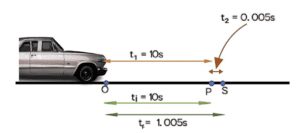
Considering the same example, the car covers OP distance in t₁ = 10s and covers the next small distance PS in t₂ = 0.005s, so the time difference will be
tᵢ = 10s (time consumed during OP)
tf = 10.005s (time consumed during OS)
∆t = tᵢ – tf
∆t = 0.005s
Here, the time interval is very small, almost equal to zero (∆t → 0). If we apply this time interval in the formula of average velocity obtained for such a small interval will be instantaneous velocity and it will be obtained at point P.
Definition
“Instantaneous velocity is average velocity when the time difference is approaching zero.”
or
“Object’s velocity at a specific point of the path is called instantaneous velocity.”
The formula of instantaneous velocity mathematically
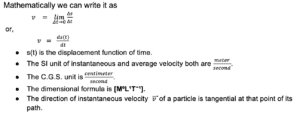

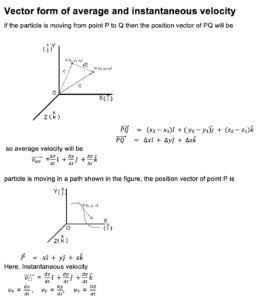
Some examples to build a better understanding (1)
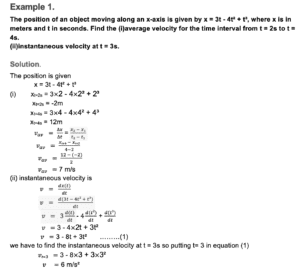

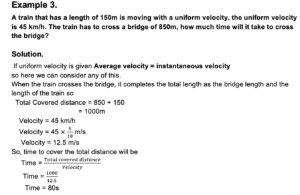
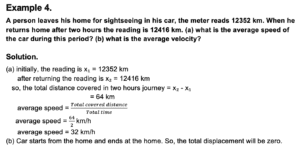
Difference between Average velocity and Instantaneous velocity
Key points |
Average velocity |
Instantaneous velocity |
| Definition | The ratio of total displacement and the total time taken by the body is average velocity. | Displacement of the body at a specific instant of time. |
| Formula | ||
| Time interval | It occurs when the time difference is large. | When the time difference is approaching zero. |
| Direction | The direction is in the direction of the displacement vector. | The direction of a particle is tangential at that point of its path |
| Uses | If we have data that is accumulated over time and the change in time is insignificant, then we use average velocity. | When data is not accumulated over time, we use instantaneous velocity. |
Difference between speed and instantaneous velocity
Key points |
Instantaneous Speed |
Instantaneous velocity |
| Definition | The magnitude of instantaneous velocity is called instantaneous speed. | Displacement of the body at a specific instant of time is |
| Formula |  |
 |
| quantity | It is a scalar quantity (only has magnitude.) | It is a vector quantity (it has magnitude and direction both) |
| Direction | Speed doesn’t have direction. | The direction of the instantaneous velocity of a particle is tangential at that point of its path |
| Uses | Speedometers in bikes and cars measure the speed. | If we want the speed with the direction of the object, then we measure instantaneous velocity. |
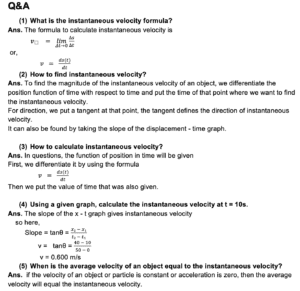
Written By: Amber Soni
References
Related topics
1. Define uniform circular motion with examples
2. What is instantaneous angular velocity?

